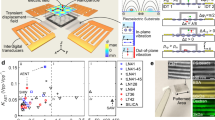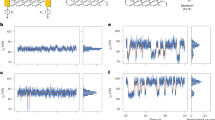Abstract
Carbon nanotubes combine a range of properties that make them well suited for use as probe tips in applications such as atomic force microscopy (AFM)1,2,3. Their high aspect ratio, for example, opens up the possibility of probing the deep crevices4 that occur in microelectronic circuits, and the small effective radius of nanotube tips significantly improves the lateral resolution beyond what can be achieved using commercial silicon tips5. Another characteristic feature of nanotubes is their ability to buckle elastically4,6, which makes them very robust while limiting the maximum force that is applied to delicate organic and biological samples. Earlier investigations into the performance of nanotubes as scanning probe microscopy tips have focused on topographical imaging, but a potentially more significant issue is the question of whether nanotubes can be modified to create probes that can sense and manipulate matter at the molecular level7. Here we demonstrate that nanotube tips with the capability of chemical and biological discrimination can be created with acidic functionality and by coupling basic or hydrophobic functionalities or biomolecular probes to the carboxyl groups that are present at the open tip ends. We have used these modified nanotubes as AFM tips to titrate the acid and base groups, to image patterned samples based on molecular interactions, and to measure the binding force between single protein–ligand pairs. As carboxyl groups are readily derivatized by a variety of reactions8, the preparation of a wide range of functionalized nanotube tips should be possible, thus creating molecular probes with potential applications in many areas of chemistry and biology.
This is a preview of subscription content, access via your institution
Access options
Subscribe to this journal
Receive 51 print issues and online access
$199.00 per year
only $3.90 per issue
Buy this article
- Purchase on Springer Link
- Instant access to full article PDF
Prices may be subject to local taxes which are calculated during checkout



Similar content being viewed by others
References
Binnig, G., Quate, C. F. & Gerber, C. Atomic force microscope. Phys. Rev. Lett. 56, 930–933 (1986).
Hansma, P. K. et al. Tapping mode atomic force microscopy in liquids. Appl. Phys. Lett. 64, 1738–1740 (1994).
Bustamante, C., Rivetti, C. & Keller, D. J. Scanning force microscopy under aqueous solutions. Curr. Opin. Struct. Biol. 7, 709–716 (1997).
Dai, H., Hafner, J. H., Rinzler, A. G., Colbert, D. T. & Smalley, R. E. Nanotubes as nanoprobes in scanning probe microscopy. Nature 384, 147–150 (1996).
Wong, S. S., Harper, J. D., Lansbury, P. T. & Lieber, C. M. Carbon nanotube tips: high-resolution probes for imaging biological systems. J. Am. Chem. Soc. 120, 603–604 (1998).
Wong, E. W., Sheehan, P. E. & Lieber, C. M. Nanobeam mechanisms: elasticity, strength and toughness of nanorods and nanotubes. Science 277, 1971–1975 (1997).
Keller, D. Ananotube molecular tool. Nature 384, 111 (1996).
March, J. Advanced Organic Chemistry (Wiley, New York, 1992).
Bodanszky, M. & Bodanszky, A. The Practice of Peptide Synthesis 2nd edn (Springer, New York, 1994).
Hiura, H., Ebbesen, T. W. & Tanigaki, K. Opening and purification of carbon nanotubes in high yields. Adv. Mater. 7, 275–276 (1995).
Evans, J. F. & Kuwant, T. Electrocatalysis of solution species using modified electrodes. J. Electroanal. Chem. 80, 409–416 (1977).
Wandass, J. H., Gardella, J. A., Weinberg, N. L., Bolster, M. E. & Salvati, L. X-ray photoelectron and scanning Auger electron spectroscopic studies of oxidized graphite electrode surfaces. J. Electrochem. Soc. 134, 2734–2739 (1987).
Frisbie, C. D., Rozsnyai, L. F., Noy, A., Wrighton, M. S. & Lieber, C. M. Functional group imaging by chemical force microscopy. Science 265, 2071–2074 (1994).
Noy, A., Vezenov, D. V. & Lieber, C. M. Functional force microscopy. Annu. Rev. Mater. Sci. 27, 381–421 (1997).
McKendry, R., Theoclitou, M.-E., Rayment, T. & Abell, C. Chiral discrimination by chemical force microscopy. Nature 391, 566–568 (1998).
Vezenov, D. V., Noy, A., Rozsnyai, L. F. & Lieber, C. M. Force titrations and ionization state imaging of functional groups in aqueous solutions by chemical force microscopy. J. Am. Chem. Soc. 119, 2006–2015 (1997).
Marti, A., Hahner, G. & Spencer, N. D. Sensitivity of frictional forces to pH on a nanometer scale: a lateral force microscopy study. Langmuir 11, 4632–4635 (1995).
Giles, M. A., Hudson, A. Q. & Borders, C. L. J Stability of water-soluble carbodiimides in aqueous solution. Anal. Biochem. 184, 244–248 (1990).
Kumar, A., Biebuyck, H. & Whitesides, G. M. Patterning self-assembled monolayers: applications in materials science. Langmuir 10, 1498–1511 (1994).
Noy, A., Sanders, C. H., Vezenov, D. V., Wong, S. S. & Lieber, C. M. Chemically-sensitive imaging in tapping mode by chemical force microscopy: relationship between phase lag and adhesion. Langmuir 14, 1508–1511 (1998).
Thess, A. et al. Crystalline ropes of metallic carbon nanotubes. Science 273, 483–487 (1996).
Livnah, O., Bayer, E. A., Wilchek, M. & Sussman, J. L. Three-dimensional structures of avidin and the avidin-biotin complex. Proc. Natl Acad. Sci. USA 90, 5076–5080 (1993).
Florin, E.-L., Moy, V. T. & Gaub, H. E. Adhesion forces between individual ligand–receptor pairs. Science 264, 415–417 (1994).
Lee, G. U., Kidwell, D. A. & Colton, R. J. Sensing discrete streptavidin-biotin interactions with atomic force microscopy. Langmuir 10, 354–357 (1994).
Wong, S. S., Woolley, A. T., Joselevich, E., Cheung, C. L. & Lieber, C. M. Covalently-functionalized single-walled carbon nanotube probe tips for chemical force microscopy. J. Am. Chem. Soc. (submitted).
Acknowledgements
We thank D. Vezenov and A. Noy for discussions. C.M.L. was supported by the US Air Force Office of Scientific Research. S.S.W., E.J. and A.T.W. acknowledge fellowships from the Natural Sciences and Engineering Research Council of Canada, the Hebrew University of Jerusalem, and the Damon Runyon-Walter Winchell Foundation, respectively.
Author information
Authors and Affiliations
Corresponding author
Rights and permissions
About this article
Cite this article
Wong, S., Joselevich, E., Woolley, A. et al. Covalently functionalized nanotubes as nanometre- sized probes in chemistry and biology. Nature 394, 52–55 (1998). https://doi.org/10.1038/27873
Received:
Accepted:
Published:
Issue Date:
DOI: https://doi.org/10.1038/27873
This article is cited by
-
A review on surface functionalization of carbon nanotubes: methods and applications
Discover Nano (2023)
-
Borophene as an carrier for mercaptopurine drug: electronic study via density‐functional theory computations
Journal of Molecular Modeling (2023)
-
Emerging zero-dimensional to four-dimensional biomaterials for bone regeneration
Journal of Nanobiotechnology (2022)
-
Engineered nanomaterials for biomedical applications and their toxicity: a review
Environmental Chemistry Letters (2022)
-
Branched Gold Nanostructures Through a Facile Fructose Mediated Microwave Route
Journal of Cluster Science (2022)
Comments
By submitting a comment you agree to abide by our Terms and Community Guidelines. If you find something abusive or that does not comply with our terms or guidelines please flag it as inappropriate.



